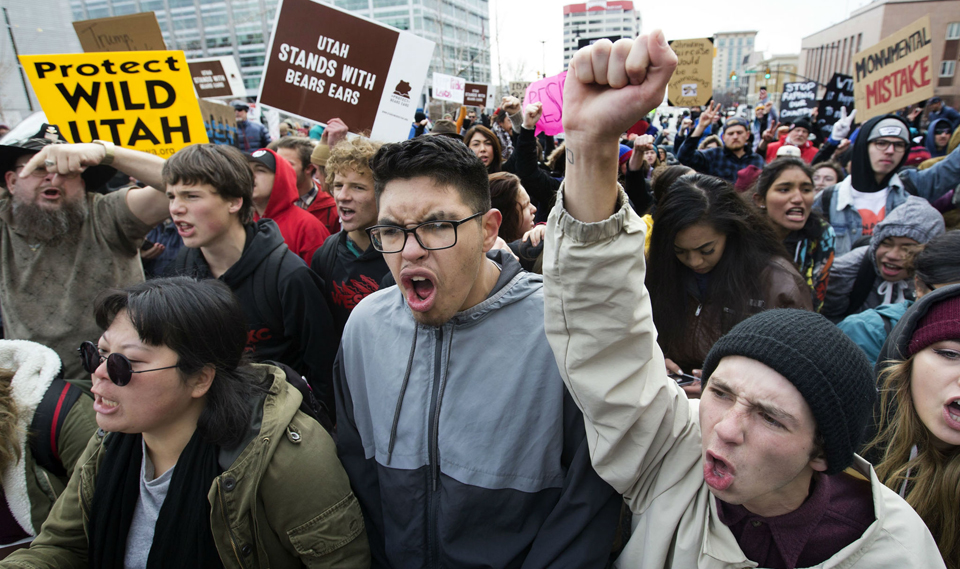
Cabins in disrepair, rusting pipelines, crumbling trails. These are some of the attributes that currently define national parks, which are in a state of crisis. Long have their problems been swept under the rug, but now President Trump plans to make matters worse, putting these parks, their wildlife, and their workers on the chopping block.
In a budget and infrastructure proposal released Feb. 12, the President recommended cutting nearly 2,000 national park workers, and suggested a funding cut of 16 percent to the Department of the Interior, which is home to the National Park Service, as well as a cut of seven percent to the park service itself. This combination of potential slashes could reduce public services at parks across the country, closing some facilities altogether, increasing the workload for remaining staff, and interfering with the maintenance of land that is crucial to wildlife. And that’s just the beginning.
Trump has been swinging the proverbial axe since December, when he announced plans to cut the size of two national parks – the Bears Ears National Monument and the Grand Staircase Escalante Monument, both in southern Utah, and all to make room for oil and gas drilling. He has now achieved those plans. The fossil fuel companies that take over those spaces will, in turn, threaten the very land they have appropriated, setting up an environmental disaster just waiting to happen. Bears Ears has been cut from 1.3 million acres to just 228,784, while Grand Staircase was cut in half, leaving it with under one million acres. The President also called for a review of two dozen other national monuments, an action in line with politicians who have complained because the areas’ designations protect them from “development.”
A quick assessment shows that national parks and monuments are in poor enough shape even without these cuts and reductions. The National Park Service currently has an $11.6 billion repair backlog, and while Trump’s budget does allocate $18 billion to fund fix-ups of public lands’ infrastructure, it is paired with increased energy leasing and development activity, as well as big rollbacks of environmental protections like the National Environmental Policy Act, sacrificing regulations and expertise of federal agency staff and expediting projects that would jeopardize clean air and water, and which would seemingly bypass review and oversight.
While national parks have been neglected for some time, it’s worth noting that previous president Barack Obama designated more than 1.6 million acres of land in Utah and Nevada as national monuments, protecting them from the sort of dirty energy drilling that Trump plans to increase.
There is also another aspect to what Trump is doing that has not been a large part of public conversation on the matter. In the decision to hand pieces of Bears Ears National Monument to oil and gas drilling corporations, no word has been given to how this would affect the tribal leaders who now manage it. Those leaders, however, have some choice words of their own for the President. The Navajo, Hopi, Pueblo of Zuni, Ute Mountain, and Ute Indians tribes consider the land to be sacred, and plan to take the Trump administration to court.
“We will be fighting back immediately,” said Natalie Landreth, an attorney for the Native American Rights Fund. “All five tribes will be standing together united to defend Bears Ears. The tribes view [Trump’s plan] as an affront to themselves and their own self-determination.” She noted that the lawsuit would be filed on the grounds that this reduction of land is a violation of the American Antiquities Act.
The gobbling up of Bears Ears land is, of course, just one part of a massive national problem. “I have a profound concern that the mission of stewardship, protection, and advancement of our national parks has been set aside,” said Tony Knowles, who recently resigned as head of the National Park Service advisory committee. The former Democratic governor of Alaska withdrew from the committee in protest of the Trump administration’s poor handling of national parks and other environmental issues, remarking that even Interior Department Secretary Ryan Zinke “appears to have no interest in continuing the agenda of science, [addressing] the effect of climate change, or pursuing the protection of the ecosystem.”
“The Trump administration is actively working to undermine our national parks and the environment on which they depend,” said John Garder, senior director of budget and appropriations at the National Parks Conservation Association. “National parks draw millions of visitors every year, and need more resources, not less. Choking off funding for staff who protect our parks puts our country’s natural, cultural, and historical heritage at risk.”
Tony Knowles added that the mistreatment and slashing of national parks is also a missed opportunity to take advantage of something that brings people together. “At a time when unity is something so lacking in discourse and political actions,” he said, “if there’s one subject that really brings Americans together of all parties, parts of the country, standards of income, all backgrounds and cultures and races, the one thing is a love of the concept of national parks.”









